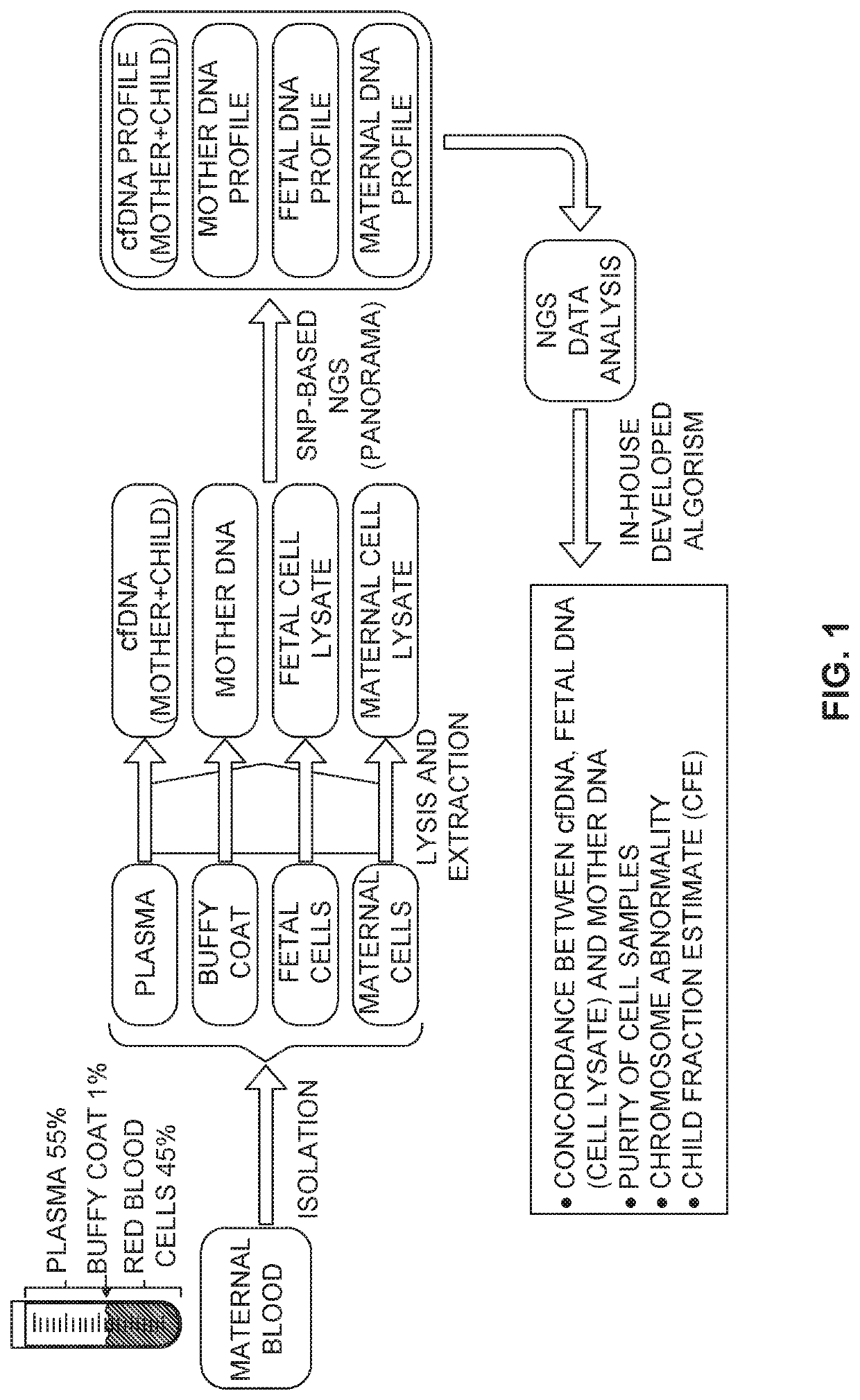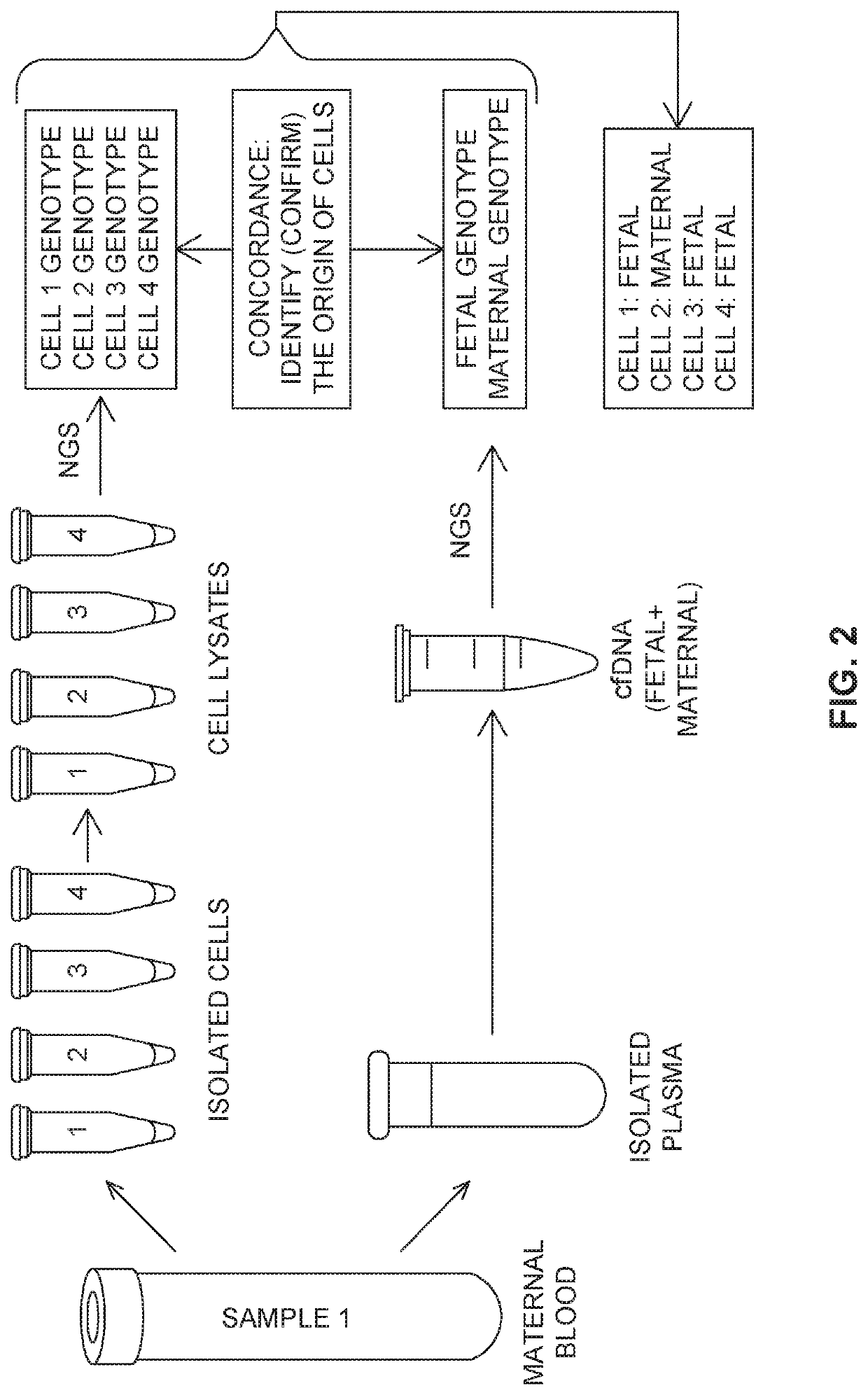Methods for analysis of circulating cells
a technology of circulating cells and methods, applied in the field of methods for analysis of circulating cells, can solve the problems of analyzing circulating cells that cannot provide the same amount of information carries the risk of potentially contributing to metastasis or surgical complications, and cannot be used in the same way as analyzing whole genome dna,
- Summary
- Abstract
- Description
- Claims
- Application Information
AI Technical Summary
Benefits of technology
Problems solved by technology
Method used
Image
Examples
working examples
Example 1
[0600]The purpose of this example was to develop a strategy for enriching DNA from a small number of cells. In particular, this example demonstrated enrichment of DNA from one single isolated fetal cell.
[0601]The model system shown in this example was designed for assessing enrichment efficiency of rare cells from blood, and in particular fetal cell enrichment and isolation. The cell line AG16777 was used for cells of fetal origin (female), the cell line AG16778 was used for cells of maternal origin, and the mixture of DNA from them as cfDNA-like reference.
[0602]The output of fetal cell enrichment process was a cell mixture in levels of ones, tens, or hundreds of cells depending on an enrichment platform. A method for assessing fetal cell enrichment efficiency needed to be able to identify fetal cell(s) and accurately estimate fetal fractions using as little as a few cells and even a single cell.
[0603]The cell mixture was generated using manual micro-pipetting of AG16777 an...
example 2
[0609]The purpose of this example was to show that methods and compositions disclosed herein can be used to analyze single cells.
[0610]The cell line AG16777 was used as a fetal cell. Under microscope, each individual cell was picked using microcapillary pipet into a PCR tube contained 5 μL of wash buffer (0.1% Bovine Serum Albumin in PBS buffer). Table 2 below shows samples comprising different number of cells used in this example.
TABLE 2Samples used for Example 2Sample NameNumber of Fetal Cells 1F 1 2F 2 4F 410F1020F20
[0611]To each of the samples shown in Table 2, 6 μL of lysis buffer (Proteinase K in Arcturus Reconstitution Buffer) was added. The reaction mixture was incubated at 56° C. for 60 minutes followed by 95° C. for 10 minutes. (Note: This procedure can be carried out in a thermocycler.) The sample mixtures (cell lysate) were cooled down and before they were run through the amplification workflow for fetal cells as described in Example 1. In particular, for the STAR 1 stag...
example 3
[0616]The purpose of this example was to test the methods of analyzing and characterizing circulating cells disclosed herein on mixtures of cells.
[0617]The cell mixture samples were prepared by picking individual fetal cells (AG16777) and individual maternal cells (AG16778) with a microcapillary pipet under a microscope. The individually picked fetal and maternal cells were then mixed in certain ratios as shown in Table 6 below.
TABLE 6Cell mixture samplesSample NameComponents of the Sample10F10 Fetal Cells 0 Maternal Cell9F1M 9 Fetal Cells 1 Maternal Cell7F3M 7 Fetal Cells 3 Maternal Cells5F5M 5 Fetal Cells 5 Maternal Cells3F7M 3 Fetal Cells 7 Maternal Cells1F4M 1 Fetal Cell 4 Maternal Cells1F9M 1 Fetal Cell 9 Maternal Cells1F19M 1 Fetal Cell19 Maternal Cells10M 0 Fetal Cell10 Maternal Cells10% CF Mix10% Child's DNA with Mom's DNA
[0618]In each sample tube, there cells were suspended in 5 μL of wash buffer (0.1% Bovine Serum Albumin in PBS buffer). To lyse the cells, 6 μL of lysis bu...
PUM
| Property | Measurement | Unit |
|---|---|---|
| Fraction | aaaaa | aaaaa |
| Volume | aaaaa | aaaaa |
| Ratio | aaaaa | aaaaa |
Abstract
Description
Claims
Application Information
 Login to View More
Login to View More - R&D
- Intellectual Property
- Life Sciences
- Materials
- Tech Scout
- Unparalleled Data Quality
- Higher Quality Content
- 60% Fewer Hallucinations
Browse by: Latest US Patents, China's latest patents, Technical Efficacy Thesaurus, Application Domain, Technology Topic, Popular Technical Reports.
© 2025 PatSnap. All rights reserved.Legal|Privacy policy|Modern Slavery Act Transparency Statement|Sitemap|About US| Contact US: help@patsnap.com



